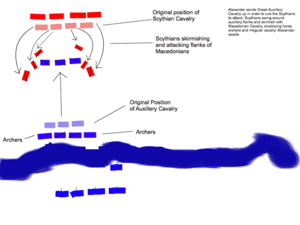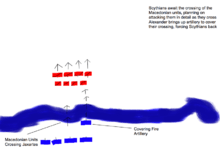Battle of Jaxartes
| ||||||||||||||||||||||||||||||
The Battle of Jaxartes was a battle fought in 329 BC by Alexander the Great and his Macedonian army against the Scythians at the Syr Darya River, the modern name for the River Jaxartes. Today the site of the battle straddles the borders of Uzbekistan, Tajikistan, Kyrgyzstan and Kazakhstan, just southwest of the ancient city of Tashkent (the modern capital of Uzbekistan) and northeast of Khujand (a city in Tajikistan).
Background
Crossing the Hellespont in 334 BCE Alexander was set on himself as the new monarch of the Achaemenid Empire. First at the Battle of the Granicus, and then at the Battle of Issus and then finally at the Battle of Gaugamela he struck a series of blows from which the Achaemenid royal house could not recover its fortunes.
During the latter two battles Alexander had been determined to capture Darius (Dar-rye-us). However, Darius had been able to secure his escape in each of these battles. Had Alexander been able to secure his capture, Darius would have been extremely useful in securing the submission of the majority of the empire. Many of the Achaemenid provinces beyond Mesopotamia were fruitful and well populated - in both comparative terms and absolutely. The climate of Bactria and Sogdiana was materially different from today.
After Gaugamela, the Macedonians were obliged to leave the battlefield where they had been victorious almost immediately. The pestilence that the corpses would have wrought on his army could have destroyed it.[2] Alexander marched on Babylon to secure his communications.[3] His intention was to make this the administrative capital of his empire.
Disposition of the armies
The Saccae had occupied the northern bank of the Jaxartes, confident that they could beat Alexander’s men as they disembarked, but underestimating the harmony with which the Macedonian artillery, fleet, cavalry, and infantry collaborated. Firstly Alexander ordered that the crossing would take place all at once, so that the mounted enemy archers would be faced with more targets than they could strike at; and he ordered his artillery to cover the soldiers in the ships. (Catapults have a longer range than bows.) This is the first recorded incident of such a thing occurring.[4]
The battle
The Saccae were thus forced from the banks by the powerful catapult and siege bows. For the Macedonians, it was now easy to cross the Jaxartes. In all likelihood the Scythians would normally have withdrawn at this point. However Alexander wanted to neutralise the threat to his borders from the nomad armies once and for all and was not about to let the enemy get away so easily. Therefore, as a second part of his strategy he ordered a battalion of mounted spearman to advance and provoke an attack from the horse-lords. The nomads did not recognize this sacrifice for what it was. In their society, in which blood feuds were common, no commander would have sacrificed troops to obtain a better position for the main force. The families of those who had been killed would immediately start a vendetta. Alexander, on the other hand, could send his mounted spearmen on this dangerous mission because his men were well trained and understood that they were not really left alone.
Alexander’s vanguard was immediately surrounded and attacked by the Scythian mounted archers. Once they were engaged, their position was fixed and they were vulnerable to an approach by the Macedonian infantry and Alexander’s cohorts of Cretan archers. The nomads now found themselves caught between the Macedonian mounted spearmen and the rest of Alexander’s army. The Saccae tried to escape to the wings of the Macedonian lines, but there they were met by Alexander’s infantry.


Aftermath and consequences
This was the end for the Scythian army - about 1200 Saccae were surrounded and killed, including their commander Satraces. Over 150 prisoners were taken and 1800 horses were captured. As far as the Macedonians and Greeks knew, no commander had ever been able to pin down and destroy a nomad army – including Darius the Great. This was a boost for morale, and a psychological blow for the nomads north of the Jaxartes. Alexander’s main aim, however, had never been to subdue the nomads; he wanted to go to the south, where a far more serious crisis demanded his attention. He could do so now without loss of face; and in order to make the outcome acceptable to the Saccae, he released the prisoners of war without ransom. This policy was successful: the northern frontier of Alexander’s empire was never seriously threatened again.
Popular culture
The second novel in Christian Cameron's Tyrant series, Storm of Arrows features the Battle of Jaxartes.
References
- ↑ Fred Eugene Ray, Jr. Greek and Macedonian land battles of the 4th century B.C. : A history and analysis of 187 engagements. McFarland & Company, 2012. p. 161
- ↑ Dodge, p.338
- ↑ Dodge, p. <?>
- 1 2 Alexander - A History of the Origin and Growth of the Art of War from the Earliest Times to the Battle of Ipsus, B.C. 301, with a Detailed Account of the Campaigns of the Great Macedonian - Theodore Ayrault Dodge - Google eBookstore. Books.google.com. 2008-11-07. Retrieved 2014-02-07.
- James R. Ashley. The Macedonian Empire: the era of warfare under Philip II and Alexander the Great. McFarland & Company, 2004.
- Arrian. Anabasis Alexandri Book 4.
- Dodge, Theodore (1890). Alexander. New York: Da Capo Press. 282-211-2.
